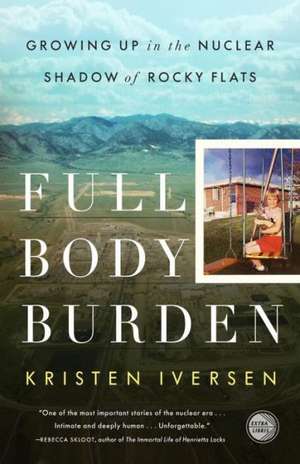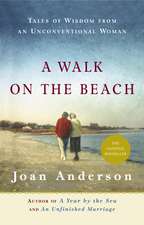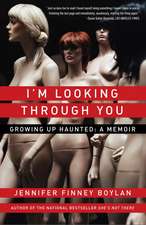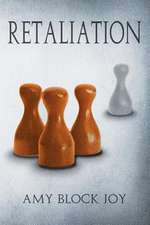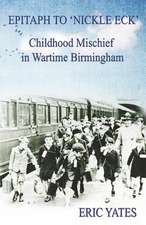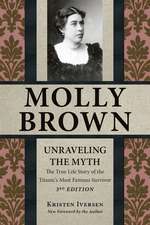Full Body Burden: Growing Up in the Nuclear Shadow of Rocky Flats
Autor Kristen Iversenen Limba Engleză Paperback – 3 iun 2013
Vezi toate premiile Carte premiată
As this memoir unfolds, it reveals itself as a brilliant work of investigative journalism—a shocking account of the government's sustained attempt to conceal the effects of the toxic and radioactive waste released by Rocky Flats, and of local residents' vain attempts to seek justice in court. Based on extensive interviews, FBI and EPA documents, and class-action testimony, this taut, beautifully written book promises to have a very long half-life.
Now with Extra Libris material, including a reader’s guide and bonus content
Preț: 100.42 lei
Nou
Puncte Express: 151
Preț estimativ în valută:
19.22€ • 20.89$ • 16.16£
19.22€ • 20.89$ • 16.16£
Carte disponibilă
Livrare economică 31 martie-14 aprilie
Preluare comenzi: 021 569.72.76
Specificații
ISBN-13: 9780307955654
ISBN-10: 0307955656
Pagini: 416
Dimensiuni: 139 x 197 x 23 mm
Greutate: 0.33 kg
Editura: BROADWAY BOOKS
ISBN-10: 0307955656
Pagini: 416
Dimensiuni: 139 x 197 x 23 mm
Greutate: 0.33 kg
Editura: BROADWAY BOOKS
Notă biografică
KRISTEN IVERSEN grew up in Arvada, Colorado, near the Rocky Flats nuclear weaponry facility. She is director of the MFA program in creative writing at the University of Memphis. Visit her website at KristenIversen.com.
Extras
1
Mother’s Day
1963
It’s 1963 and I’m five. I lie across the backseat of the family car, sleeping with my cheek pressed against the vinyl. My mother sits in the front with baby Karin and my father drives, carefully holding his cigarette just at the window’s edge. This is how I remember my mother and father: smoking in a cool, elegant way that makes me want to grow up quick so I can smoke, too. It’s evening and I’m tired and cranky. The spring day has been spent on a long drive through the Colorado mountains, a Sunday ritual.
We turn the corner to our home on Johnson Court, the square little house my parents bought when my father left his job as an attorney for an insurance company and set up his own law practice. The neighborhood is made up of winding rows of houses that all look like ours: a front door and a picture window facing the street, two windows on each side, and a sliding door in the back that opens to a postage-stamp backyard. We have a view of the mountains and one tree.
“Uh-oh,” my mother says.
“Jesus.” My dad stops the car. I scramble to my knees to look.
Our house is smoldering. One side is gone. A fire truck and a police car with streaking red lights stand in the driveway.
My dad jumps out and my mom reaches over and pulls up the parking brake. “Dick,” she says, “I’m taking Kris to the neighbor’s.” My mother is always good in a crisis.
Mrs. Hauschild is waiting at her door. She takes a pair of pajamas from her daughter’s room--we’re almost the same age--and she beds me down in the basement in a sleeping bag. “She’ll be fine here,” Mrs. Hauschild says. “She doesn’t need to see all that commotion.” She suggests they both have a drink and a cigarette. My mother nods.
“Someone must have left the lamp on in Kris’s bedroom,” my mother says as they walk up the stairs. “The drapes caught on fire.”
I repeat these words in my head until I come to believe I set the fire myself. I can still picture my bedside lamp, the brass switch, the round orange globe always warm to the touch.
Years later--decades, in fact--my father laughs when I tell him this story. “You didn’t cause that fire, Kris,” he says. “Your mother and I did. We had been sitting and talking in the living room, having a drink together, and we left a burning cigarette in the ashtray. Neither of us noticed. The drapes in the living room caught fire first.” The flames never reached my room.
This is how I want to remember my parents: still talking to each other, even when the world was tumbling down around their ears.
We rent a basement apartment for a month and then move back to our rebuilt house. Nothing is ever said about the fire. Nothing is ever said about dark or sad or upsetting events, and anything that involves liquor is definitely not discussed. My parents are elegant drinkers. My mother can make a Manhattan with just the right splash of whiskey and vermouth. My father takes his bourbon straight on ice. After dinner, once my mother has tucked us into bed, my parents make cocktails and play cribbage to determine who has to do the dishes. From my bedroom I can hear my mother’s soft laugh. Sometimes there’s a stack of unwashed plates in the sink when we leave for school in the morning.
Soon another baby is born: my sister Karma. This is not a hippie name, despite the fact that we live close to Boulder. My mother insists on naming her daughters after her Norwegian heritage: Kristen, Karin, Karma.
At the top of the hill behind our house stands the Arvada cemetery. The year 1863 is etched in a stone marker at the entrance. The cemetery works like a magnet. As soon as our mother puts us out into the yard for the afternoon--just like the kids and grandkids on the family farm back in Iowa, who were expected to fend for themselves for the day--Karin and I scramble over the fence and head for the hill. We are our own secret club, and Karma joins us as soon as she is old enough to toddle along. Sometimes the other neighbor girls--Paula, Susie, and Kathy--are allowed into the club as temporary members. We trek across the field behind the row of backyards and through the old apple orchard and get up to the creek, where we balance a flat plank across the shallow, sluggish water and tiptoe across. Water spiders dance across the surface and tiny minnows scatter when we push our toes into the muddy bottom.
At the crest of the hill stand row after row of headstones. Some are tall, others flat against the ground. Some have the names of children or images of their faces etched in the stone, and we stay away from those. We run up and down the rows, shrieking and gathering up the plastic flowers. We pile all our flowers in the middle and sit in a circle around them. We look down the hill to our house and imagine our mother, big and round, lying on her bed and waiting for the next baby, a boy at last, she’s sure of it. A little farther, we can see the Arvada Villa Pizza Parlor and the Arvada Beauty Academy. Between our neighborhood and the long dark line of mountains stands a single white water tower, all by itself. The Rocky Flats water tower. There is a hidden factory there.
That hidden factory is the Rocky Flats Nuclear Weapons Plant, a foundry that smelts plutonium, purifies it, and shapes it into plutonium “triggers” for nuclear bombs. The plant also recycles fissionable material from outmoded bombs. A largely blue-collar link in the U.S. government’s nuclear bomb network, Rocky Flats is the only plant in the country that produces these triggers--small, spherical explosives that provide an atomic bomb’s chain reaction. The triggers form the heart of every nuclear weapon made in America. From 1952 to 1989, Rocky Flats manufactures more than seventy thousand plutonium triggers, at a cost of nearly $4 million apiece. Each one contains enough breathable particles of plutonium to kill every person on earth.
Rocky Flats’ largest output, however, is radioactive and toxic waste. In all the decades of nuclear weapons production, the nuclear weapons industry produces waste with too little thought to the future or the environment. The creation of each gram of plutonium produces radioactive waste, virtually all of which remains with us to the present day.
But no one in our community knows what goes on at Rocky Flats. This is a secret operation, not subject to any laws of the state.
The wind blows, as it always does. I imagine the bones of pioneers and cowboys beneath our feet. The chill of evening begins to creep up the hill; the air turns cold when the sun dips.
“Let’s go!” Karin yells, and we jump to our feet and roll and tumble down the hill. We bounce across the plank and race across the field, full speed, before the sun sets and the ghosts come out.
In the beginning, Rocky Flats is called Project Apple. In 1951, years before I’m born, a group of men from the Atomic Energy Commission (AEC) meet in an old hotel off the beaten track in Denver. No press, no publicity. Their job is to find a site to build a secret bomb factory that will carry out the work that first began with the Manhattan Project, the covert military endeavor that developed the first atomic bomb during World War II.
Until now, all nuclear bombs in the United States have been custom-built at the weapons research and design laboratory at Los Alamos, New Mexico, with materials supplied from the plutonium production facility at the Hanford site in eastern Washington State and the uranium enrichment facility at Oak Ridge, Tennessee. But with the heightening Cold War--a high state of military tension and political conflict with the Soviet Union and its allies that will continue for decades--the United States wants to mass-produce nuclear weapons. They need a roll-up-your-sleeves, get-down-to-business, high-production bomb factory. An assembly line.
AEC officials choose a site on a high, windy plateau not far from the growing cities of Arvada, Boulder, and Denver--cities that can provide workers and housing. Landowners are forced to sell their land to the government, and construction on Project Apple begins immediately.
A few months later, the Denver Post breaks the news of the new plant with the headline there is good news today: AEC to Build $45 Million A-plant Near Denver. Announcement of the plant catches everyone by surprise, including state and city officials, and the news breaks like a thunderbolt over the community. Though owned by the AEC, the plant will be operated by Dow Chemical, a private contractor that will be indemnified against any accident or mishap. The Rocky Flats Nuclear Weapons Plant will become the workhorse of an AEC complex of weapons facilities that eventually spans thirteen states, from Nevada to Kansas to South Carolina. Each AEC facility will be involved in its own particular aspect of the design, manufacture, testing, and maintenance of weapons for the U.S. nuclear arsenal.
Components and processes will be divided up around the country, but Rocky Flats will be the only site designed to produce the fissionable plutonium “pits” at the core of nuclear bombs. The whole system depends upon Rocky Flats.
Construction of the plant is rushed.
Few people know the deal is in the works. Not even the governor has an inkling. Colorado’s top elected officials are not informed that the plant will be built until after the decision is made and there’s no going back. But Denver welcomes the windfall. No one knows what the factory will produce. No one cares. It means jobs. It means housing. Contractors, the local power plant, and local businesses all look forward to the “juicy plum” to be known from now on as Rocky Flats.
It’s the Cold War. The bombs dropped on Hiroshima and Nagasaki in 1945 may have ended one war, but they started another. The perceived Soviet threat is an ever-present shadow in American life. The Atomic Energy Act of 1946 creates an impenetrable wall of secrecy around the U.S. nuclear establishment. All government decisions and activities related to the production of nuclear weapons will be completely hidden. Information about nuclear bombs, toxic and radioactive waste, environmental contamination, and known and unknown health risks to workers and local residents is all strictly classified.
And no one asks questions.
An editorial in the Denver Post predicts that Rocky Flats will be “a source of satisfaction to all residents who have an abiding faith in Colorado’s destiny and future greatness.” The newspaper reports that workers on the project will be safer than “downtown office workers who have to cross busy streets on their way to lunch.”
The announcement is made simultaneously in Denver, Los Alamos, and Washington, D.C. The plant site in Jefferson County has been chosen for “operational values,” including the fact that the land is nothing but an old rocky cow pasture, “virtual waste land.” Officials from the AEC emphasize that no atom bombs or weapons will be built at Rocky Flats, only some unspecified component parts. The plant will not give off “dangerous wastes” or use large quantities of water, gas, and electricity. When questioned further by reporters, AEC spokesman Dick Elliott states adamantly, “Atomic bombs will not be built at this plant.”
One small but devastating error escapes notice. The site criteria specifically state that the wind passing over the plant should not blow toward a major population center. But there is a mistake in the engineering report. Engineers base their analysis on wind patterns at Stapleton Airport, on the other side of Denver, where winds come from the south. Rocky Flats is well known for extreme weather conditions--rain, sleet, snow, and especially the prevailing winds, including chinooks that travel down the eastern slope of the Rockies from the west and northwest, directly over Rocky Flats and straight toward Arvada, Westminster, Broomfield, and Denver. Called “snow eaters,” chinook winds occur when the jet stream dips down and hits the fourteeners--the 14,000-foot mountains west of Denver--where they lose their moisture. The winds warm as they race down the lee side of the mountain range, and by the time they reach flat land, they’re hot and often exceed 100 miles per hour. Snow melts overnight. Sometimes chinooks snap telephone poles, blow out windshields, and overturn vehicles in the area around Rocky Flats.
One employee who notices the error is Jim Stone. An engineer hired to help design Rocky Flats before it opens, Stone is a careful and thorough man. Born during the Depression, he was sent to a Catholic orphanage when his parents couldn’t afford to raise him. His path to becoming an engineer has been hard won, and he brings years of experience to his job at Rocky Flats. He warns against the location of the plant “because Denver is downwind a few miles away.” He is ignored.
The name Rocky Flats is taken from the dry, rolling land dotted with sage and pine trees, a name chosen by early homesteaders who raised cattle and hay. Now it will no longer be ranchland. The money is in housing. Jefferson County and the entire Denver area are booming. Just over half a million in 1950, by 1969 the population of the Denver metro area has more than doubled. Jefferson and Boulder counties are two of the fastest-growing counties in the entire country. Thomas Mills, the mayor of Arvada, worries about housing. Rocky Flats plans to hire at least a thousand permanent workers immediately, and unlike in other nuclear towns, such as Los Alamos, workers will not be housed on-site. “The housing situation is rough here. We’ll receive the brunt of all that traffic to the plant because we’re on the only direct route to it,” Mills says. “The city is comprised mostly of small homes. There really is only one large apartment house. . . . It’s going to cause us lots of headaches.” By the first week of March 1951, extensive new home construction has begun.
The plant is surrounded by two tiers of barbed-wire fence stretching ten miles around the circumference of the core area. The first tier, three feet high, is to keep cattle out. The second tier, nine feet high, is electrified and patrolled by guards with guns, high-powered binoculars, and, eventually, tanks. With the exception of a two-story administration building, the plant’s buildings are built low to the ground, in ravines cut deep into the soil. The factory is almost completely invisible from the road. By early 1952, things are in full production. By 1957, nearly 1,600 people work at Rocky Flats. Radioactive and toxic waste have to be dealt with from the beginning. Effluence is run through a regular sewage disposal plant and empties into nearby Woman Creek. Solid and liquid waste is packed into fifty-five-gallon drums. Much of what remains is incinerated. What spews from the smokestacks of the production buildings is expected to disperse by the time it reaches the outer limits of the plant boundary.
Mother’s Day
1963
It’s 1963 and I’m five. I lie across the backseat of the family car, sleeping with my cheek pressed against the vinyl. My mother sits in the front with baby Karin and my father drives, carefully holding his cigarette just at the window’s edge. This is how I remember my mother and father: smoking in a cool, elegant way that makes me want to grow up quick so I can smoke, too. It’s evening and I’m tired and cranky. The spring day has been spent on a long drive through the Colorado mountains, a Sunday ritual.
We turn the corner to our home on Johnson Court, the square little house my parents bought when my father left his job as an attorney for an insurance company and set up his own law practice. The neighborhood is made up of winding rows of houses that all look like ours: a front door and a picture window facing the street, two windows on each side, and a sliding door in the back that opens to a postage-stamp backyard. We have a view of the mountains and one tree.
“Uh-oh,” my mother says.
“Jesus.” My dad stops the car. I scramble to my knees to look.
Our house is smoldering. One side is gone. A fire truck and a police car with streaking red lights stand in the driveway.
My dad jumps out and my mom reaches over and pulls up the parking brake. “Dick,” she says, “I’m taking Kris to the neighbor’s.” My mother is always good in a crisis.
Mrs. Hauschild is waiting at her door. She takes a pair of pajamas from her daughter’s room--we’re almost the same age--and she beds me down in the basement in a sleeping bag. “She’ll be fine here,” Mrs. Hauschild says. “She doesn’t need to see all that commotion.” She suggests they both have a drink and a cigarette. My mother nods.
“Someone must have left the lamp on in Kris’s bedroom,” my mother says as they walk up the stairs. “The drapes caught on fire.”
I repeat these words in my head until I come to believe I set the fire myself. I can still picture my bedside lamp, the brass switch, the round orange globe always warm to the touch.
Years later--decades, in fact--my father laughs when I tell him this story. “You didn’t cause that fire, Kris,” he says. “Your mother and I did. We had been sitting and talking in the living room, having a drink together, and we left a burning cigarette in the ashtray. Neither of us noticed. The drapes in the living room caught fire first.” The flames never reached my room.
This is how I want to remember my parents: still talking to each other, even when the world was tumbling down around their ears.
We rent a basement apartment for a month and then move back to our rebuilt house. Nothing is ever said about the fire. Nothing is ever said about dark or sad or upsetting events, and anything that involves liquor is definitely not discussed. My parents are elegant drinkers. My mother can make a Manhattan with just the right splash of whiskey and vermouth. My father takes his bourbon straight on ice. After dinner, once my mother has tucked us into bed, my parents make cocktails and play cribbage to determine who has to do the dishes. From my bedroom I can hear my mother’s soft laugh. Sometimes there’s a stack of unwashed plates in the sink when we leave for school in the morning.
Soon another baby is born: my sister Karma. This is not a hippie name, despite the fact that we live close to Boulder. My mother insists on naming her daughters after her Norwegian heritage: Kristen, Karin, Karma.
At the top of the hill behind our house stands the Arvada cemetery. The year 1863 is etched in a stone marker at the entrance. The cemetery works like a magnet. As soon as our mother puts us out into the yard for the afternoon--just like the kids and grandkids on the family farm back in Iowa, who were expected to fend for themselves for the day--Karin and I scramble over the fence and head for the hill. We are our own secret club, and Karma joins us as soon as she is old enough to toddle along. Sometimes the other neighbor girls--Paula, Susie, and Kathy--are allowed into the club as temporary members. We trek across the field behind the row of backyards and through the old apple orchard and get up to the creek, where we balance a flat plank across the shallow, sluggish water and tiptoe across. Water spiders dance across the surface and tiny minnows scatter when we push our toes into the muddy bottom.
At the crest of the hill stand row after row of headstones. Some are tall, others flat against the ground. Some have the names of children or images of their faces etched in the stone, and we stay away from those. We run up and down the rows, shrieking and gathering up the plastic flowers. We pile all our flowers in the middle and sit in a circle around them. We look down the hill to our house and imagine our mother, big and round, lying on her bed and waiting for the next baby, a boy at last, she’s sure of it. A little farther, we can see the Arvada Villa Pizza Parlor and the Arvada Beauty Academy. Between our neighborhood and the long dark line of mountains stands a single white water tower, all by itself. The Rocky Flats water tower. There is a hidden factory there.
That hidden factory is the Rocky Flats Nuclear Weapons Plant, a foundry that smelts plutonium, purifies it, and shapes it into plutonium “triggers” for nuclear bombs. The plant also recycles fissionable material from outmoded bombs. A largely blue-collar link in the U.S. government’s nuclear bomb network, Rocky Flats is the only plant in the country that produces these triggers--small, spherical explosives that provide an atomic bomb’s chain reaction. The triggers form the heart of every nuclear weapon made in America. From 1952 to 1989, Rocky Flats manufactures more than seventy thousand plutonium triggers, at a cost of nearly $4 million apiece. Each one contains enough breathable particles of plutonium to kill every person on earth.
Rocky Flats’ largest output, however, is radioactive and toxic waste. In all the decades of nuclear weapons production, the nuclear weapons industry produces waste with too little thought to the future or the environment. The creation of each gram of plutonium produces radioactive waste, virtually all of which remains with us to the present day.
But no one in our community knows what goes on at Rocky Flats. This is a secret operation, not subject to any laws of the state.
The wind blows, as it always does. I imagine the bones of pioneers and cowboys beneath our feet. The chill of evening begins to creep up the hill; the air turns cold when the sun dips.
“Let’s go!” Karin yells, and we jump to our feet and roll and tumble down the hill. We bounce across the plank and race across the field, full speed, before the sun sets and the ghosts come out.
In the beginning, Rocky Flats is called Project Apple. In 1951, years before I’m born, a group of men from the Atomic Energy Commission (AEC) meet in an old hotel off the beaten track in Denver. No press, no publicity. Their job is to find a site to build a secret bomb factory that will carry out the work that first began with the Manhattan Project, the covert military endeavor that developed the first atomic bomb during World War II.
Until now, all nuclear bombs in the United States have been custom-built at the weapons research and design laboratory at Los Alamos, New Mexico, with materials supplied from the plutonium production facility at the Hanford site in eastern Washington State and the uranium enrichment facility at Oak Ridge, Tennessee. But with the heightening Cold War--a high state of military tension and political conflict with the Soviet Union and its allies that will continue for decades--the United States wants to mass-produce nuclear weapons. They need a roll-up-your-sleeves, get-down-to-business, high-production bomb factory. An assembly line.
AEC officials choose a site on a high, windy plateau not far from the growing cities of Arvada, Boulder, and Denver--cities that can provide workers and housing. Landowners are forced to sell their land to the government, and construction on Project Apple begins immediately.
A few months later, the Denver Post breaks the news of the new plant with the headline there is good news today: AEC to Build $45 Million A-plant Near Denver. Announcement of the plant catches everyone by surprise, including state and city officials, and the news breaks like a thunderbolt over the community. Though owned by the AEC, the plant will be operated by Dow Chemical, a private contractor that will be indemnified against any accident or mishap. The Rocky Flats Nuclear Weapons Plant will become the workhorse of an AEC complex of weapons facilities that eventually spans thirteen states, from Nevada to Kansas to South Carolina. Each AEC facility will be involved in its own particular aspect of the design, manufacture, testing, and maintenance of weapons for the U.S. nuclear arsenal.
Components and processes will be divided up around the country, but Rocky Flats will be the only site designed to produce the fissionable plutonium “pits” at the core of nuclear bombs. The whole system depends upon Rocky Flats.
Construction of the plant is rushed.
Few people know the deal is in the works. Not even the governor has an inkling. Colorado’s top elected officials are not informed that the plant will be built until after the decision is made and there’s no going back. But Denver welcomes the windfall. No one knows what the factory will produce. No one cares. It means jobs. It means housing. Contractors, the local power plant, and local businesses all look forward to the “juicy plum” to be known from now on as Rocky Flats.
It’s the Cold War. The bombs dropped on Hiroshima and Nagasaki in 1945 may have ended one war, but they started another. The perceived Soviet threat is an ever-present shadow in American life. The Atomic Energy Act of 1946 creates an impenetrable wall of secrecy around the U.S. nuclear establishment. All government decisions and activities related to the production of nuclear weapons will be completely hidden. Information about nuclear bombs, toxic and radioactive waste, environmental contamination, and known and unknown health risks to workers and local residents is all strictly classified.
And no one asks questions.
An editorial in the Denver Post predicts that Rocky Flats will be “a source of satisfaction to all residents who have an abiding faith in Colorado’s destiny and future greatness.” The newspaper reports that workers on the project will be safer than “downtown office workers who have to cross busy streets on their way to lunch.”
The announcement is made simultaneously in Denver, Los Alamos, and Washington, D.C. The plant site in Jefferson County has been chosen for “operational values,” including the fact that the land is nothing but an old rocky cow pasture, “virtual waste land.” Officials from the AEC emphasize that no atom bombs or weapons will be built at Rocky Flats, only some unspecified component parts. The plant will not give off “dangerous wastes” or use large quantities of water, gas, and electricity. When questioned further by reporters, AEC spokesman Dick Elliott states adamantly, “Atomic bombs will not be built at this plant.”
One small but devastating error escapes notice. The site criteria specifically state that the wind passing over the plant should not blow toward a major population center. But there is a mistake in the engineering report. Engineers base their analysis on wind patterns at Stapleton Airport, on the other side of Denver, where winds come from the south. Rocky Flats is well known for extreme weather conditions--rain, sleet, snow, and especially the prevailing winds, including chinooks that travel down the eastern slope of the Rockies from the west and northwest, directly over Rocky Flats and straight toward Arvada, Westminster, Broomfield, and Denver. Called “snow eaters,” chinook winds occur when the jet stream dips down and hits the fourteeners--the 14,000-foot mountains west of Denver--where they lose their moisture. The winds warm as they race down the lee side of the mountain range, and by the time they reach flat land, they’re hot and often exceed 100 miles per hour. Snow melts overnight. Sometimes chinooks snap telephone poles, blow out windshields, and overturn vehicles in the area around Rocky Flats.
One employee who notices the error is Jim Stone. An engineer hired to help design Rocky Flats before it opens, Stone is a careful and thorough man. Born during the Depression, he was sent to a Catholic orphanage when his parents couldn’t afford to raise him. His path to becoming an engineer has been hard won, and he brings years of experience to his job at Rocky Flats. He warns against the location of the plant “because Denver is downwind a few miles away.” He is ignored.
The name Rocky Flats is taken from the dry, rolling land dotted with sage and pine trees, a name chosen by early homesteaders who raised cattle and hay. Now it will no longer be ranchland. The money is in housing. Jefferson County and the entire Denver area are booming. Just over half a million in 1950, by 1969 the population of the Denver metro area has more than doubled. Jefferson and Boulder counties are two of the fastest-growing counties in the entire country. Thomas Mills, the mayor of Arvada, worries about housing. Rocky Flats plans to hire at least a thousand permanent workers immediately, and unlike in other nuclear towns, such as Los Alamos, workers will not be housed on-site. “The housing situation is rough here. We’ll receive the brunt of all that traffic to the plant because we’re on the only direct route to it,” Mills says. “The city is comprised mostly of small homes. There really is only one large apartment house. . . . It’s going to cause us lots of headaches.” By the first week of March 1951, extensive new home construction has begun.
The plant is surrounded by two tiers of barbed-wire fence stretching ten miles around the circumference of the core area. The first tier, three feet high, is to keep cattle out. The second tier, nine feet high, is electrified and patrolled by guards with guns, high-powered binoculars, and, eventually, tanks. With the exception of a two-story administration building, the plant’s buildings are built low to the ground, in ravines cut deep into the soil. The factory is almost completely invisible from the road. By early 1952, things are in full production. By 1957, nearly 1,600 people work at Rocky Flats. Radioactive and toxic waste have to be dealt with from the beginning. Effluence is run through a regular sewage disposal plant and empties into nearby Woman Creek. Solid and liquid waste is packed into fifty-five-gallon drums. Much of what remains is incinerated. What spews from the smokestacks of the production buildings is expected to disperse by the time it reaches the outer limits of the plant boundary.
Recenzii
"Full Body Burden is one of the most important stories of the nuclear era--as personal and powerful as "Silkwood," told with the suspense and narrative drive of The Hot Zone. With unflinching honesty, Kristen Iverson has written an intimate and deeply human memoir that shows why we should all be concerned about nuclear safety, and the dangers of ignoring science in the name of national security. Rocky Flats needs to be part of the same nuclear discussion as Three Mile Island, Chernobyl, and Fukushima. So does Full Body Burden. It's an essential and unforgettable book that should be talked about in schools and book clubs, online and in the White House."
—Rebecca Skloot, author of The Immortal Life of Henrietta Lacks
"What a surprise! You don't expect such (unobtrusively) beautiful writing in a book about nuclear weapons, nor such captivating storytelling. Plus the facts are solid and the science told in colloquial but never dumbed-down terms. If I could afford them, I'd want the movie rights. Having read scores of nuclear books, I venture a large claim: Kristin Iversen's Full Body Burden may be a classic of nuclear literature, filling a gap we didn't know existed among Hersey's Hiroshima, Burdick and Wheeler's Fail-Safe and Kohn's Who Killed Karen Silkwood?"
—Mark Hertsgaard, author of Nuclear Inc. and HOT
"This terrifyingly brilliant book--as perfectly crafted and meticulously assembled as the nuclear bomb triggers that lie at its core--is a savage indictment of the American strategic weapons industry, both haunting in its power, and yet wonderfully, charmingly human as a memoir of growing up in the Atomic Age."
—Simon Winchester, author of The Professor and the Madman and Atlantic
"Why didn't Poe or Hitchcock think of this? Full Body Burden has all the elements of a classic horror tale: the charming nuclear family cruising innocently above the undercurrents of nuclear nightmare. But it's true and all the more chilling. Kristen Iversen has lived this life and is an authority on the culture of secrecy that has prevented the nation from knowing the truth about radioactive contamination. This is a gripping and scary story."
—Bobbie Ann Mason, author of Shiloh and Other Stories and In Country
"Kristen Iversen has written a hauntingly beautiful memoir that is also a devastating investigation into the human costs of building and living with the atomic bomb. Poignant and gracefully written, Iversen shows us what it meant to come of age next door to Rocky Flats--America’s plutonium bomb factory. The story is at once terrifying and outrageous."
—Kai Bird, co-author of American Prometheus: The Triumph and Tragedy of J. Robert Oppenheimer
"The fight over Rocky Flats was and is a paradigmatic American battle, of corporate and government power set against the bravery and anger of normal people. This is a powerful and beautiful account, of great use to all of us who will fight the battles that lie ahead."
—Bill McKibben, author of The End of Nature and Eaarth
"Part memoir, part investigative journalism, Full Body Burden is a tale that will haunt your dreams. It's a story of secrecy, deceit, and betrayal set in the majestic high plains of Colorado. Kristen Iversen takes us behind her family's closed doors and beyond the security fences and the armed guards at Rocky Flats. She's as honest and restrained in her portrait of a family in crisis as she is in documenting the incomprehensible betrayal of citizens by their government, in exposing the harrowing disregard for public safety exhibited by the technocrats in charge of a top-secret nuclear weapons facility. For decades the question asked by residents living downwind of the plant was 'Would my government deliberately put my life and the lives of my children in danger?' The simple and irrefutable answer was 'Yes, it would . . . in a Colorado minute.'"
—John Dufresne, author of Louisiana Power & Light and Love Warps the Mind a Little
“This is a subject as grippingly immediate as today's headlines: While there is alarm about the small rise in radioactivity in the food chain, one reads in these pages about how a whole region lived in the steady contaminating effects of nuclear radiation. Kristen Iversen's prose is clean and clear and lovely, and her story is deeply involving and full of insight and knowledge; it begins in innocence, and moves through catastrophes; it is unflinching and brave, an expose about ignorance and denial and the cost of government excess, and an intensely personal portrait of a family. It ought to be required reading for every single legislator in this country.”
—Richard Bausch, author of Peace and Something Is Out There
—Rebecca Skloot, author of The Immortal Life of Henrietta Lacks
"What a surprise! You don't expect such (unobtrusively) beautiful writing in a book about nuclear weapons, nor such captivating storytelling. Plus the facts are solid and the science told in colloquial but never dumbed-down terms. If I could afford them, I'd want the movie rights. Having read scores of nuclear books, I venture a large claim: Kristin Iversen's Full Body Burden may be a classic of nuclear literature, filling a gap we didn't know existed among Hersey's Hiroshima, Burdick and Wheeler's Fail-Safe and Kohn's Who Killed Karen Silkwood?"
—Mark Hertsgaard, author of Nuclear Inc. and HOT
"This terrifyingly brilliant book--as perfectly crafted and meticulously assembled as the nuclear bomb triggers that lie at its core--is a savage indictment of the American strategic weapons industry, both haunting in its power, and yet wonderfully, charmingly human as a memoir of growing up in the Atomic Age."
—Simon Winchester, author of The Professor and the Madman and Atlantic
"Why didn't Poe or Hitchcock think of this? Full Body Burden has all the elements of a classic horror tale: the charming nuclear family cruising innocently above the undercurrents of nuclear nightmare. But it's true and all the more chilling. Kristen Iversen has lived this life and is an authority on the culture of secrecy that has prevented the nation from knowing the truth about radioactive contamination. This is a gripping and scary story."
—Bobbie Ann Mason, author of Shiloh and Other Stories and In Country
"Kristen Iversen has written a hauntingly beautiful memoir that is also a devastating investigation into the human costs of building and living with the atomic bomb. Poignant and gracefully written, Iversen shows us what it meant to come of age next door to Rocky Flats--America’s plutonium bomb factory. The story is at once terrifying and outrageous."
—Kai Bird, co-author of American Prometheus: The Triumph and Tragedy of J. Robert Oppenheimer
"The fight over Rocky Flats was and is a paradigmatic American battle, of corporate and government power set against the bravery and anger of normal people. This is a powerful and beautiful account, of great use to all of us who will fight the battles that lie ahead."
—Bill McKibben, author of The End of Nature and Eaarth
"Part memoir, part investigative journalism, Full Body Burden is a tale that will haunt your dreams. It's a story of secrecy, deceit, and betrayal set in the majestic high plains of Colorado. Kristen Iversen takes us behind her family's closed doors and beyond the security fences and the armed guards at Rocky Flats. She's as honest and restrained in her portrait of a family in crisis as she is in documenting the incomprehensible betrayal of citizens by their government, in exposing the harrowing disregard for public safety exhibited by the technocrats in charge of a top-secret nuclear weapons facility. For decades the question asked by residents living downwind of the plant was 'Would my government deliberately put my life and the lives of my children in danger?' The simple and irrefutable answer was 'Yes, it would . . . in a Colorado minute.'"
—John Dufresne, author of Louisiana Power & Light and Love Warps the Mind a Little
“This is a subject as grippingly immediate as today's headlines: While there is alarm about the small rise in radioactivity in the food chain, one reads in these pages about how a whole region lived in the steady contaminating effects of nuclear radiation. Kristen Iversen's prose is clean and clear and lovely, and her story is deeply involving and full of insight and knowledge; it begins in innocence, and moves through catastrophes; it is unflinching and brave, an expose about ignorance and denial and the cost of government excess, and an intensely personal portrait of a family. It ought to be required reading for every single legislator in this country.”
—Richard Bausch, author of Peace and Something Is Out There
Premii
- ALA Notable Books Winner, 2013
- Discover Great New Writers Finalist, 2012
- Colorado Book Award Winner, 2013
- Reading the West Winner, 2012
